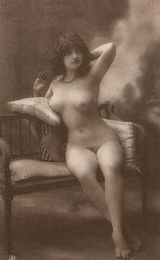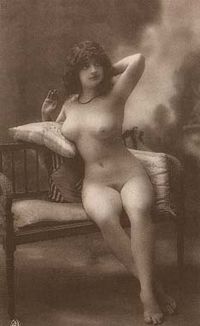
History of erotic photography
Encyclopedia


Nudity and sexuality
In most societies and cultures, human nudity is often associated with sexuality. Many people are sexually attracted to nudity, which they find to be erotic and sexually arousing...
nature. Though the subjects of erotic photography are usually completely or mostly unclothed
Nudity
Nudity is the state of wearing no clothing. The wearing of clothing is exclusively a human characteristic. The amount of clothing worn depends on functional considerations and social considerations...
, that is not a requirement. Erotic photography dating from 1835 until the 1960s is often referred to in the years since as vintage photography. Erotic photography should be distinguished from pornographic photography, which is of a sexually explicit nature.
Beginnings
Depictions of nudity before 1835 generally consisted of paintings and drawings. That year, Louis DaguerreLouis Daguerre
Louis-Jacques-Mandé Daguerre was a French artist and physicist, recognized for his invention of the daguerreotype process of photography.- Biography :...
invented the first practical process of photography. Unlike earlier photographs, his daguerreotype
Daguerreotype
The daguerreotype was the first commercially successful photographic process. The image is a direct positive made in the camera on a silvered copper plate....
s had stunning quality and did not fade with time. The new technology did not go unnoticed by artists eager for new ways to depict the undraped feminine form.
In Nude Photography, 1840–1920, Peter Marshall notes: "In the prevailing moral climate at the time of the invention of photography, the only officially sanctioned photography of the body was for the production of artist's studies. Many of the surviving examples of daguerreotypes are clearly not in this genre but have a sensuality that clearly implies they were designed as erotic or pornographic images".
The daguerreotypes were not without drawbacks, however. The main difficulty was that they could only be reproduced by photographing the original picture. In addition, the earliest daguerreotypes had exposure times ranging from three to fifteen minutes, making them somewhat impractical for portraiture. Since one picture could cost a week's salary, the audience for nudes mostly consisted of artists and the upper echelon of society. Nude stereoscopy
Stereoscopy
Stereoscopy refers to a technique for creating or enhancing the illusion of depth in an image by presenting two offset images separately to the left and right eye of the viewer. Both of these 2-D offset images are then combined in the brain to give the perception of 3-D depth...
began in 1838 and became extremely popular.
French influence
The initial appearance of picture postcards (and the enthusiasm with which the new medium was embraced) raised some legal issues that can be seen as precursors to later controversies over the internet. Picture postcards allowed and encouraged many individuals to send images across national borders, and the legal availability of a postcard image in one country did not guarantee that the card would be considered "proper" in the destination country, or in the intermediate countries that the card would have to pass through. Some countries refused to handle postcards containing sexual references (in seaside postcards) or images of full or partial nudity (for instance, in images of classical statuary or paintings).Instead, nudes were marketed in a monthly magazine called "La Beaute" that targeted artists looking for poses. Each issue contained 75 nude images which could be ordered by mail, in the form of postcards, hand-tinted or sepia toned. Street dealers, tobacco shops, and a variety of other vendors bought the photographs for resale to tourists.
Early 20th century
The early 1900s saw several important improvements in camera design, including the 1913 invention of the 35 mm or "candid" camera by Oskar BarnackOskar Barnack
Oskar Barnack was a German optical engineer, precision mechanic, industrial designer and the father of 35mm photography....
of the Ernst Leitz company. The Ur-Leica was a compact camera based on the idea of reducing the format of negatives and enlarging them later, after they had been exposed. This small, portable device made nude photography in secluded parks and other semi-public places easier, and represented a great advance for amateur erotica. Artists were enamored with their new ability to take impromptu photos without carrying around a clunky apparatus.
Early 20th century artist E. J. Bellocq
E. J. Bellocq
John Ernest Joseph Bellocq was an American professional photographer who worked in New Orleans during the early 20th century. Bellocq is remembered for his haunting photographs of the prostitutes of Storyville, New Orleans' legalized red light district...
, who made his best known images with the older style glass plate negatives, is best remembered for his down-to-earth pictures of prostitutes in domestic settings in the Storyville
Storyville
Storyville was the red-light district of New Orleans, Louisiana, from 1897 through 1917. Locals usually simply referred to the area as The District.-History:...
red light district of New Orleans. In contrast to the usual pictures of women awkwardly posed amid drapery, veils, flowers, fruit, classical columns and oriental braziers, Bellocq's sitters appear relaxed and comfortable. David Steinberg speculates that the prostitutes may have felt at ease with Bellocq because he was "so much of a fellow outcast."
Julian Mandel
Julian Mandel
"Julian Mandel" is the identity given to one of the best-known commercial photographers of female nudes of the early twentieth century...
became known in the 1920s and 1930s for his exceptional photographs of the female form. Participating in the German "new age outdoor movement," Mandel took numerous pictures in natural settings, publishing them through the Paris-based studios of A. Noyer and PC Paris. A Johns Hopkins University
Johns Hopkins University
The Johns Hopkins University, commonly referred to as Johns Hopkins, JHU, or simply Hopkins, is a private research university based in Baltimore, Maryland, United States...
scholarship was named in his honor.
Another noteworthy nude photographer of the first two decades of the 20th century was Arundel Holmes Nicholls. His work, featured in the archives of the Kinsey Institute, is artistically composed, often giving an iridescent glow to his figures. Following in Mandel's footsteps, Nicholls favored outdoor shots.
Many photographs from this era are damaged; Bellocq, for instance, frequently scratched out the faces of his sitters to obscure their identities. Some of his other sitters were photographed wearing masks. Peter Marshall writes, "Even in the relatively bohemian atmosphere of Carmel, California in the 1920s and '30s, Edward Weston
Edward Weston
Edward Henry Weston was a 20th century American photographer. He has been called "one of the most innovative and influential American photographers…" and "one of the masters of 20th century photography." Over the course of his forty-year career Weston photographed an increasingly expansive set of...
had to photograph many of his models without showing their faces, and some 75 years on, many communities are less open about such things than Carmel was then."
Photographers around the middle of the century of note are Walter Bird, John Everard, Horace Roye
Horace Roye
Horace Roye was one of the 20th century's pioneering photographers. Roye's photo Tomorrow's Crucifixion, depicting a nude model wearing a gas mask while pinned to a crucifix caused controversy when published in the North London Recorder in August 1938, but is now recognised as one the major...
, Harrison Marks
Harrison Marks
George Harrison Marks was a British glamour photographer and director of nudist, and later, pornographic films who was active in the fields for several decades.-Kamera and Pamela Green:...
and Zoltán Glass
Zoltán Glass
Zoltån Glass was an Anglo-Hungarian photographer. Born in Budapest, Hungary, in 1925 he started working as a cartoonist and retoucher. In 1931 Zoltån moved to Berlin where he established himself as a photographer. A keen motorsport enthusiast, Glass covered most of the big races at the Nürburgring...
. Roye's photograph Tomorrow's Crucifixion, depicting a model wearing a gas mask
Gas mask
A gas mask is a mask put on over the face to protect the wearer from inhaling airborne pollutants and toxic gases. The mask forms a sealed cover over the nose and mouth, but may also cover the eyes and other vulnerable soft tissues of the face. Some gas masks are also respirators, though the word...
while on a crucifix
Crucifix
A crucifix is an independent image of Jesus on the cross with a representation of Jesus' body, referred to in English as the corpus , as distinct from a cross with no body....
caused much controversy when published in the English Press in 1938. The image is now considered one of the major pre-war photographs of the 20th century.
While there is some overlap in the time periods, the term erotic photography begin to be less commonly applied to such photography after the 1960s. After this time, the term glamour photography is more commonly used.
See also
- Erotic artErotic artErotic art covers any artistic work that is intended to evoke erotic arousal or that depicts scenes of love-making. It includes paintings, engravings, drawings, sculptures, photographs, music and writing.-Definition:...
- Glamour photographyGlamour photographyGlamour photography is a genre of photography whereby the subjects, usually female, are portrayed in a romantic or sexually alluring way. The subjects may be fully clothed or seminude, but glamour photography stops short of deliberately arousing the viewer and being pornographic photography.Glamour...
- History of erotic depictionsHistory of erotic depictionsThe history of erotic depictions includes paintings, sculpture, photographs, dramatic arts, music and writings that show scenes of a sexual nature throughout time. They have been created by nearly every civilisation, ancient and modern. Early cultures often associated the sexual act with...

